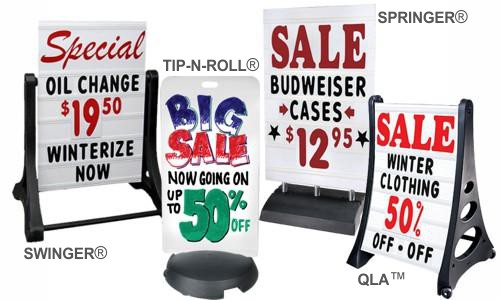4 Tips for Using Your Sidewalk Sign to Drive More Sales
14th Feb 2021

From boutiques to restaurants, sidewalk signs are a common form of portable, storefront signage in areas with high foot traffic—used to grab the attention of passersby, raise brand awareness, and/or communicate deals. Popular because of their low price point, portable nature, and opportunities for customization, sidewalk signs are an ideal outdoor signage solution for businesses, schools, and churches who need the flexibility to promote short-term messages, whether outside their building or on-the-go.
Unfortunately, a few key benefits that make sidewalk signs so appealing are also the reasons they often get overlooked. Whereas outdoor LED signs and changeable letter signs are generally large and sit high off the ground, sidewalk signs generally sit below eye-level and their size limits the amount of information you can display. That why it’s essential when you’re creating a sidewalk sign to thinking critically about how to make your message strategic and actionable, so that you can catch and maintain the interest of potential customers passing by. As a starting point, we’ve pulled together a few guidelines based on 4 of the 5 W’s: Who, What, Why, and When.
Who You Are
If you do not have a large sign outside your store that features your name or logo, then it is important to include that information on your sidewalk sign. While it may not be the most important element on your sign, you do need to clearly identify who you are. Whether it be your logo, a branded element, or simply your name, it is essential for brand awareness that customers passing by your storefront can see your name—which means it needs to be readable. If using an image, be sure it is clear, not cluttered, and that there is color contrast. If using only type, choose a simple font in a dark color that will be easy to read from a distance.
What You Do & Why Should They Choose You
The most important thing you can do on your sidewalk sign is to give potential customers a reason to walk into your establishment. In order to do that they need to know what it is you do or what sets you apart from the competition—or both. For example, while a clever joke on the sign outside your coffee shop is unique and may draw some customers in, it doesn’t tell passersby anything about your products or services. Instead, it would be more effective to use a message like “Jane Doe Coffee Shop—Come warm up with a pumpkin spice latte or just a plain ole’ cup of delicious coffee.” Now customers who walk by will know that you’re a coffee shop with a breadth of options. Another highly-effective approach would be to offer potential customers something compelling. “Jane Doe Coffee Shop—Stop in today for 10% off a medium latte!” In this case you’ve given passersby a reason to walk into your shop that sets you apart from other local coffee shops.
When They Should Stop By
Finally, provide some context for potential customers about when they should stop by your shop. One consistent way to do that is to include your hours of operation in the same place on your sign every day, letting people know when they can come in and take advantage of your offer or regular services. In an example like the one above, it is important to let passersby know when your offer is available to them. Improve your call to action by adding a specific time frame: “Jane Doe Coffee Shop—Stop in today from 10 – 2 for 10% off a medium latte!” The more details you can provide, the more control you have over what kind of customers will come into your establishment and when. The example above might attract local business people during their lunch breaks or students with flexible schedule, while an offer that’s available from 5 – 7 will likely attract people on their way home from work.
Sidewalk signs are cost-effective and durable solution for attracting new or repeat customers into your store. As you consider what to include on your sidewalk sign, first think about what is important and interesting to your target audience; then adapt the details about who you are, what you do, what makes you different, and when people should stop by your stop.
